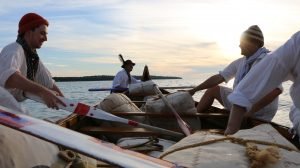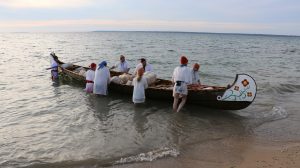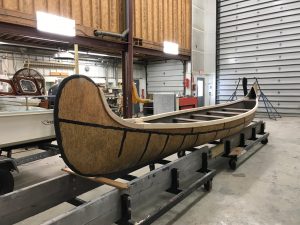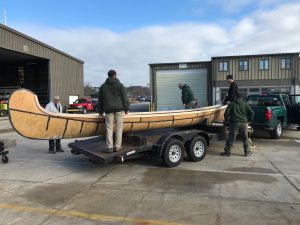Today, thousands of people travel to the Straits of Mackinac every summer, most of them by car. Similar numbers of people came to this area  in the 18th century, but traveled in a very different vehicle, a birch bark canoe.
in the 18th century, but traveled in a very different vehicle, a birch bark canoe.
 Europeans encountered these canoes as they pushed west into the Great Lakes region in the 17th century. Built by Native American craftsmen, birch bark canoes were lightweight, easily maneuverable, and relatively simple to maintain. As French and British merchants traveled to the Great Lakes in increasing numbers to trade with indigenous trappers, they too adopted the canoe as their primary means of transportation. Given the rarity of overland roads or trails, canoes were often the only means of reaching isolated communities such as Michilimackinac. They could quickly and efficiently navigate both inland rivers and the near-shore waters of the Great Lakes, making them ideal for moving tons of furs and trade goods between backcountry trading centers, such as Michilimackinac, and larger cities such as Montreal.
Europeans encountered these canoes as they pushed west into the Great Lakes region in the 17th century. Built by Native American craftsmen, birch bark canoes were lightweight, easily maneuverable, and relatively simple to maintain. As French and British merchants traveled to the Great Lakes in increasing numbers to trade with indigenous trappers, they too adopted the canoe as their primary means of transportation. Given the rarity of overland roads or trails, canoes were often the only means of reaching isolated communities such as Michilimackinac. They could quickly and efficiently navigate both inland rivers and the near-shore waters of the Great Lakes, making them ideal for moving tons of furs and trade goods between backcountry trading centers, such as Michilimackinac, and larger cities such as Montreal.
As Europeans adopted the birch bark canoe as the cargo truck of the fur trade, canoe designs became somewhat standardized, with different types employed in specific situations. Indian canoes, the smallest, fastest, and lightest craft, were 14 to 16 feet long, required only two paddlers, and were similar in many respects to a modern canoe. The canot du Nord, or north canoes, were 24 to 28 feet long and crewed by four to six paddlers. Capable of carrying about 3,000 pounds, including the crew and their provisions, these canoes were typically used to connect interior trading centers, such as Michilimackinac, with satellite posts and Native communities. North canoes were the most common  type used in the Great Lakes fur trade, and could travel up to six miles per hour, or even faster if a sail were used. The largest canoes were the canot du Maître, or master canoes (sometimes also called Montreal canoes). Developed in the 1730s, these massive vessels measured up to 40 feet long and could carry 7,000 to 9,000 pounds of cargo. Thanks to their size and weight, these canoes required a crew of at least eight paddlers, although some larger vessels required as many as 14. These largest canoes were used to ferry massive amounts of furs and trade goods between Montreal and trade centers such as Michilimackinac. Beyond these three general canoe designs, there were also several other types of intermediate size called canot bâtard, or bastard canoes.
type used in the Great Lakes fur trade, and could travel up to six miles per hour, or even faster if a sail were used. The largest canoes were the canot du Maître, or master canoes (sometimes also called Montreal canoes). Developed in the 1730s, these massive vessels measured up to 40 feet long and could carry 7,000 to 9,000 pounds of cargo. Thanks to their size and weight, these canoes required a crew of at least eight paddlers, although some larger vessels required as many as 14. These largest canoes were used to ferry massive amounts of furs and trade goods between Montreal and trade centers such as Michilimackinac. Beyond these three general canoe designs, there were also several other types of intermediate size called canot bâtard, or bastard canoes.
Modern visitors to Colonial Michilimackinac can see examples of all three of the major canoe types. A birchbark Indian canoe is on display in the France at Mackinac exhibit, while a full-sized canot du Maître can be seen in the Visitor’s Center. Fiberglass reproductions of a canot du Maître and a canot du nord make up the setting of the Voyageur Landing, where visitors can meet an interpreter representing a French Canadian canoe crewman and learn more about these versatile watercraft. One of these canoes was refurbished over the winter thanks to the generosity of Mackinac Associates. Join us at Colonial Michilimackinac on  June 30-July 1 for Rendezvous at the Straits, a celebration of voyageur culture, to see these canoes in action.
June 30-July 1 for Rendezvous at the Straits, a celebration of voyageur culture, to see these canoes in action.









